Overview
- Brief Narrative
- Enamel cup used in the slave labor camp in Berlin when Irena Ehrlich vel Sluzny worked for the Schwartzkopf Fabrik in 1943. She carried the cup with her when she walked from Berlin to Warsaw in 1945, in search of her family. Irena, her parents, Felicia and Seweryn, and younger sister, Danuta, were confined to the Warsaw ghetto in 1940. In March 1943, 19 year old Irena escaped to the Christian sector of Warsaw. April 1943 brought the Warsaw ghetto uprising and its violent suppression by the Germans, with mass deportations of all Jews in Warsaw and the annihilation of the ghetto. Her father, aged 39, was killed during the uprising. Her mother and 14 year old sister escaped and were hidden for the rest of the war by Juana Dylag. Irena was deported to a slave labor camp in Berlin. Felicia, Danuta, and Irena were reunited in Warsaw after the war. From 1945-1947, they were in the Bindermichl displaced persons camp in Linz, Austria. They emigrated to the United States on the SS Marine Perch in 1947.
- Date
-
use:
1943-1947
- Geography
-
use:
slave labor camp;
Berlin (Germany)
- Credit Line
- United States Holocaust Memorial Museum Collection, Gift of Irena Urdang deTour
- Markings
- bottom, stamped : 6 cm / Made in Poland
- Contributor
-
Subject:
Irena Urdang DeTour
- Biography
-
Irena de Tour was born in 1924 in Warsaw, Poland, the daughter of Seweryn Ehrlich vel Sluszny and Felicja Lubelczyk Ehrlich. She had a younger sister, Danuta, born in 1929. Irena attended the Perla Lbinska Gimnazjum. In September 1939, Germany invaded Poland. Irena and her family were confined to the Warsaw ghetto in November 1940, where she worked in an Electropol factory. Irena escaped the ghetto to the Christian section of Warsaw in March 1943 and acquired false documents and work as a maid. Following the suppression of the Warsaw ghetto uprising that year, Irena was sent to a slave labor camp in Berlin, along with her aunt. She was assigned to work in the Schwartzkopf ammunition factory. In September 1944, Irena joined the underground resistance - building barricades, organizing shelters, and working for the Red Cross. After the war ended in May 1945, Irena walked to Warsaw to search for family members. Her father had died in the Warsaw ghetto uprising. But she found her mother and sister and, together, they were placed in Bindermichl displaced persons camp in Linz, Austria. Irena worked for the United Nations Refugee Relief Agency (UNRRA) as an interpreter and secretary. In 1947, the family emigrated to the United States on the SS Marine Perch and settled in New York City. Irena graduated from Hunter College in 1956. She has two children and runs an antique business in Connecticut.
Physical Details
- Language
- English
- Classification
-
Household Utensils
- Category
-
Drinking vessels
- Object Type
-
Drinking cups (lcsh)
- Physical Description
- Red enamel cup with a c-shaped handle, a flat base, and flared walls that widen at the opening. There is black enamel on the rim and the inside is blue enamel.
- Dimensions
- overall: Height: 2.625 inches (6.668 cm) | Width: 3.375 inches (8.573 cm) | Depth: 2.625 inches (6.668 cm)
- Materials
- overall : metal, enamel paint
Rights & Restrictions
- Conditions on Access
- No restrictions on access
- Conditions on Use
- No restrictions on use
Keywords & Subjects
Administrative Notes
- Legal Status
- Permanent Collection
- Provenance
- The cup was donated to the United States Holocaust Memorial Museum in 2008 by Irena Urdang de Tour, the daughter of Felicia and Seweryn Ehrlich vel Sluszny.
- Record last modified:
- 2023-07-19 12:10:02
- This page:
- https://collections.ushmm.org/search/catalog/irn42237
Download & Licensing
In-Person Research
- By Appointment
- Request 21 Days in Advance of Visit
- Plan a Research Visit
- Request to See This Object
Contact Us
Also in Irena Urdang de Tour family collection
The collection consists of artifacts and a photograph relating to the experiences of Irena Ehrlich vel Sluszny (now Urdang de Tour) and her family in Warsaw and the Warsaw ghetto in Poland before and during the Holocaust, to Irena's experiences in a slave labor factory in Berlin, and in Bindermichl displaced persons camp in Linz, Austria, after the Holocaust.
Date: 1940-1947
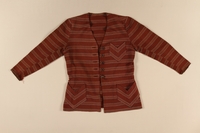
Striped wool jacket used in the Warsaw ghetto
Object
Jacket worn by Felicia Ehrlich vel Sluszny in the Warsaw ghetto and Bindermichl displaced persons camp. It was hand-woven by peasants in Zakopane in the Carpathian Mountains in 1939. Felicia, her husband, Seweryn, and her two daughters, 16 year old Irena and 11 year old Danuta, were confined to the Warsaw ghetto in 1940. In March 1943, Irena escaped to the Christian sector of Warsaw. April 1943 brought the Warsaw ghetto uprising and its violent suppression by the Germans, with mass deportations of all Jews in Warsaw and the annihilation of the ghetto. Seweryn, aged 39, was killed during the uprising. Felicia and Danuta escaped and were hidden for the rest of the war by Juana Dylag. Irena was deported to a slave labor camp in Berlin. Felicia, Danuta, and Irena were reunited in Warsaw after the war. From 1945-1947, they were in Bindermichl displaced persons camp in Linz, Austria. They emigrated to the United States on the SS Marine Perch in 1947.
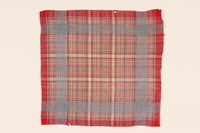
Red plaid handkerchief used in the Warsaw ghetto
Object
Handkerchief used in the Warsaw ghetto and in the Bindermichl displaced persons camp by Irena Ehrlich vel Sluszny, her parents, Felicia and Seweryn, and younger sister, Danuta, were confined to the Warsaw ghetto in 1940. In March 1943, 19 year old Irena escaped to the Christian sector of Warsaw. April 1943 brought the Warsaw ghetto uprising and its violent suppression by the Germans, with mass deportations of all Jews in Warsaw and the annihilation of the ghetto. Her father, aged 39, was killed during the uprising. Her mother and 14 year old sister escaped and were hidden for the rest of the war by Juana Dylag. Irena was deported to a slave labor camp in Berlin. Felicia, Danuta, and Irena were reunited in Warsaw after the war. From 1945-1947, they were in the Bindermichl displaced persons camp in Linz, Austria. They emigrated to the United States on the SS Marine Perch in 1947.
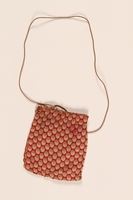
Red drawstring pouch used in the Warsaw ghetto
Object
Drawstring pouch worn by Irena Ehrlich vel Sluszny around her neck to keep valuables throughout the Holocaust. Irena, her parents, Felicia and Seweryn, and younger sister, Danuta, were confined to the Warsaw ghetto in 1940. In March 1943, 19 year old Irena escaped to the Christian sector of Warsaw. April 1943 brought the Warsaw ghetto uprising and its violent suppression by the Germans, with mass deportations of all Jews in Warsaw and the annihilation of the ghetto. Her father, aged 39, was killed during the uprising. Her mother and 14 year old sister escaped and were hidden for the rest of the war by Juana Dylag. Irena was deported to a slave labor camp in Berlin. Felicia, Danuta, and Irena were reunited in Warsaw after the war. From 1945-1947, they were in the Bindermichl displaced persons camp in Linz, Austria. They emigrated to the United States on the SS Marine Perch in 1947.
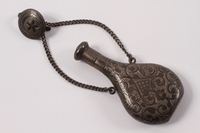
Engraved silver perfume bottle carried postwar by a refugee searching for her family
Object
Perfume bottle engraved with Irena Ehrlich von Sluzny's initials, IE. She carried this with her when she walked from Berlin to Warsaw in 1945, in search of her family. Irena, her parents, Felicia and Seweryn, and younger sister, Danuta, were confined to the Warsaw ghetto in 1940. In March 1943, 19 year old Irena escaped to the Christian sector of Warsaw. April 1943 brought the Warsaw ghetto uprising and its violent suppression by the Germans, with mass deportations of all Jews in Warsaw and the annihilation of the ghetto. Her father, aged 39, was killed during the uprising. Her mother and 14 year old sister escaped and were hidden for the rest of the war by Juana Dylag. Irena was deported to a slave labor camp in Berlin. Felicia, Danuta, and Irena were reunited in Warsaw after the war. From 1945-1947, they were in the Bindermichl displaced persons camp in Linz, Austria. They emigrated to the United States on the SS Marine Perch in 1947.

Darning needle and case used in the Warsaw ghetto
Object
Darning needle used by Irena Ehrlich vel Sluszny and her family in the Warsaw ghetto. Irena, her parents, Felicia and Seweryn, and younger sister, Danuta, were confined to the Warsaw ghetto in 1940. In March 1943, 19 year old Irena escaped to the Christian sector of Warsaw. April 1943 brought the Warsaw ghetto uprising and its violent suppression by the Germans, with mass deportations of all Jews in Warsaw and the annihilation of the ghetto. Her father, aged 39, was killed during the uprising. Her mother and 14 year old sister escaped and were hidden for the rest of the war by Juana Dylag. Irena was deported to a slave labor camp in Berlin. Felicia, Danuta, and Irena were reunited in Warsaw after the war. From 1945-1947, they were in the Bindermichl displaced persons camp in Linz, Austria. They emigrated to the United States on the SS Marine Perch in 1947.
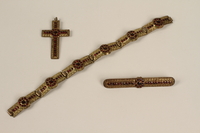
Gold necklace, bracelet, and pendant received in a displaced persons camp
Object
Jewelry set given to Irena Ehrlich vel Sluszny’s family by Julius Balbin in the Bindermichl displaced persons camp after the war. Balbin was an Auschwitz survivor, who met the family in Bindermichl in 1945. Irena, her parents, Felicia and Seweryn, and younger sister, Danuta, were confined to the Warsaw ghetto in 1940. In March 1943, 19 year old Irena escaped to the Christian sector of Warsaw. April 1943 brought the Warsaw ghetto uprising and its violent suppression by the Germans, with mass deportations of all Jews in Warsaw and the annihilation of the ghetto. Her father, aged 39, was killed during the uprising. Her mother and 14 year old sister escaped and were hidden for the rest of the war by Juana Dylag. Irena was deported to a slave labor camp in Berlin. Felicia, Danuta, and Irena were reunited in Warsaw after the war. From 1945-1947, they were in the Bindermichl displaced persons camp in Linz, Austria. They emigrated to the United States on the SS Marine Perch in 1947.

Thermometer with silver case used in the Warsaw ghetto
Object
Thermometer and case used by Felicia Ehrlich vel Sluszny in Warsaw, Poland, before and during the Holocaust. Felicia, her husband, Seweryn, and her two daughters, 16 year old Irena and 11 year old Danuta, were confined to the Warsaw ghetto in 1940. In March 1943, Irena escaped to the Christian sector. April 1943 brought the Warsaw ghetto uprising and its violent suppression by the Germans, with mass deportations of all Jews in Warsaw and the annihilation of the ghetto. Seweryn, aged 39, was killed during the uprising. Felicia and Danuta escaped and were hidden the rest of the war by Juana Dylag. Irena was deported to a slave labor camp in Berlin. Felicia, Danuta, and Irena were reunited in Warsaw after the war. From 1945-1947, they were in Bindermichl displaced persons camp in Linz, Austria. They emigrated to the United States on the SS Marine Perch in 1947.
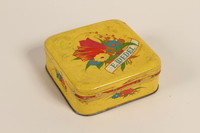
E. Wedel candy tin received in a displaced persons camp
Object
Candy tin made in Poland in 1945 acquired by Irena Ehrlich vel Sluszny and her family while in the Bindermichl displace persons camp. Irena, her parents, Felicia and Seweryn, and younger sister, Danuta, were confined to the Warsaw ghetto in 1940. In March 1943, 19 year old Irena escaped to the Christian sector of Warsaw. April 1943 brought the Warsaw ghetto uprising and its violent suppression by the Germans, with mass deportations of all Jews in Warsaw and the annihilation of the ghetto. Her father, aged 39, was killed during the uprising. Her mother and 14 year old sister escaped and were hidden for the rest of the war by Juana Dylag. Irena was deported to a slave labor camp in Berlin. Felicia, Danuta, and Irena were reunited in Warsaw after the war. From 1945-1947, they were in the Bindermichl displaced persons camp in Linz, Austria. They emigrated to the United States on the SS Marine Perch in 1947.
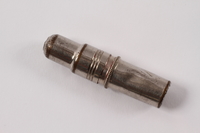
Sewing needle case used for lipstick in the Warsaw ghetto
Object
Sewing needle case used as a lipstick case in the Warsaw ghetto by Irena Ehrlich vel Sluszny. Irena, her parents, Felicia and Seweryn, and younger sister, Danuta, were confined to the Warsaw ghetto in 1940. In March 1943, 19 year old Irena escaped to the Christian sector of Warsaw. April 1943 brought the Warsaw ghetto uprising and its violent suppression by the Germans, with mass deportations of all Jews in Warsaw and the annihilation of the ghetto. Her father, aged 39, was killed during the uprising. Her mother and 14 year old sister escaped and were hidden for the rest of the war by Juana Dylag. Irena was deported to a slave labor camp in Berlin. Felicia, Danuta, and Irena were reunited in Warsaw after the war. From 1945-1947, they were in the Bindermichl displaced persons camp in Linz, Austria. They emigrated to the United States on the SS Marine Perch in 1947.
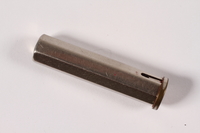
Ritz of Paris lipstick case used in the Warsaw ghetto
Object
Lipstick case used in the Warsaw ghetto by Irena Ehrlich vel Sluszny. Irena, her parents, Felicia and Seweryn, and younger sister, Danuta, were confined to the Warsaw ghetto in 1940. In March 1943, 19 year old Irena escaped to the Christian sector of Warsaw. April 1943 brought the Warsaw ghetto uprising and its violent suppression by the Germans, with mass deportations of all Jews in Warsaw and the annihilation of the ghetto. Her father, aged 39, was killed during the uprising. Her mother and 14 year old sister escaped and were hidden for the rest of the war by Juana Dylag. Irena was deported to a slave labor camp in Berlin. Felicia, Danuta, and Irena were reunited in Warsaw after the war. From 1945-1947, they were in the Bindermichl displaced persons camp in Linz, Austria. They emigrated to the United States on the SS Marine Perch in 1947.

Dinner spoon used by an inmate in a slave labor camp
Object
Spoon from a silverware set used by Irena Ehrlich vel Sluszny in the slave labor camp in Berlin where she worked for the Schwartzkopf Fabrik in 1943. Irena, her parents, Felicia and Seweryn, and younger sister, Danuta, were confined to the Warsaw ghetto in 1940. In March 1943, 19 year old Irena escaped to the Christian sector of Warsaw. April 1943 brought the Warsaw ghetto uprising and its violent suppression by the Germans, with mass deportations of all Jews in Warsaw and the annihilation of the ghetto. Her father, aged 39, was killed during the uprising. Her mother and 14 year old sister escaped and were hidden for the rest of the war by Juana Dylag. Irena was deported to a slave labor camp in Berlin. Felicia, Danuta, and Irena were reunited in Warsaw after the war. From 1945-1947, they were in the Bindermichl displaced persons camp in Linz, Austria. They emigrated to the United States on the SS Marine Perch in 1947.
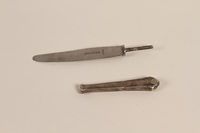
Detachable knife used by an inmate in a slave labor camp
Object
Knife from a silverware set used by Irena Ehrlich vel Sluszny in the slave labor camp in Berlin when she worked for the Schwartzkopf Fabrik in 1943. Irena, her parents, Felicia and Seweryn, and younger sister, Danuta, were confined to the Warsaw ghetto in 1940. In March 1943, 19 year old Irena escaped to the Christian sector of Warsaw. April 1943 brought the Warsaw ghetto uprising and its violent suppression by the Germans, with mass deportations of all Jews in Warsaw and the annihilation of the ghetto. Her father, aged 39, was killed during the uprising. Her mother and 14 year old sister escaped and were hidden for the rest of the war by Juana Dylag. Irena was deported to a slave labor camp in Berlin. Felicia, Danuta, and Irena were reunited in Warsaw after the war. From 1945-1947, they were in the Bindermichl displaced persons camp in Linz, Austria. They emigrated to the United States on the SS Marine Perch in 1947.

Silver floral patterned dinner fork used by an inmate in a slave labor camp
Object
Fork from a silverware set used by Irena Urdang de Tour in the slave labor camp in Berlin when she worked for the Schwartzkopf Fabrik in 1943. Irena Ehrlich vel Sluszny (now Urdang de Tour), her parents, Felicia and Seweryn, and younger sister, Danuta, were confined to the Warsaw ghetto in 1940. In March 1943, 19 year old Irena escaped to the Christian sector of Warsaw. April 1943 brought the Warsaw ghetto uprising and its violent suppression by the Germans, with mass deportations of all Jews in Warsaw and the annihilation of the ghetto. Her father, aged 39, was killed during the uprising. Her mother and 14 year old sister escaped and were hidden for the rest of the war by Juana Dylag. Irena was deported to a slave labor camp in Berlin. Felicia, Danuta, and Irena were reunited in Warsaw after the war. From 1945-1947, they were in the Bindermichl displaced persons camp in Linz, Austria. They emigrated to the United States on the SS Marine Perch in 1947.
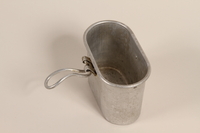
Metal soup canteen used by an inmate in a slave labor camp
Object
Metal soup canteen used by Irena Ehrlich vel Sluszny in the slave labor camp in Berlin when she worked for the Schwartzkopf Fabrik in 1943. Irena, her parents, Felicia and Seweryn, and younger sister, Danuta, were confined to the Warsaw ghetto in 1940. In March 1943, 19 year old Irena escaped to the Christian sector of Warsaw. April 1943 brought the Warsaw ghetto uprising and its violent suppression by the Germans, with mass deportations of all Jews in Warsaw and the annihilation of the ghetto. Her father, aged 39, was killed during the uprising. Her mother and 14 year old sister escaped and were hidden for the rest of the war by Juana Dylag. Irena was deported to a slave labor camp in Berlin. Felicia, Danuta, and Irena were reunited in Warsaw after the war. From 1945-1947, they were in the Bindermichl displaced persons camp in Linz, Austria. They emigrated to the United States on the SS Marine Perch in 1947.

4711 glass perfume bottle carried by a Jewish refugee searching for her family
Object
Perfume bottle carried by Irena Ehrlich vel Sluszny when she walked from Berlin to Warsaw in 1945, in search of her family. Irena, her parents, Felicia and Seweryn, and younger sister, Danuta, were confined to the Warsaw ghetto in 1940. In March 1943, 19 year old Irena escaped to the Christian sector of Warsaw. April 1943 brought the Warsaw ghetto uprising and its violent suppression by the Germans, with mass deportations of all Jews in Warsaw and the annihilation of the ghetto. Her father, aged 39, was killed during the uprising. Her mother and 14 year old sister escaped and were hidden for the rest of the war by Juana Dylag. Irena was deported to a slave labor camp in Berlin. Felicia, Danuta, and Irena were reunited in Warsaw after the war. From 1945-1947, they were in the Bindermichl displaced persons camp in Linz, Austria. They emigrated to the United States on the SS Marine Perch in 1947.

Parker Lucky Curve duofold fountain pen used in the Warsaw ghetto
Object
Orange plastic fountain pen owned by Irena Ehrlich vel Sluszny that originally belonged to her father, Seweryn, who was killed at age 39, during the Warsaw ghetto uprising in April 1943. Irena, her parents, Felicia and Seweryn, and younger sister, Danuta, were confined to the Warsaw ghetto in 1940. In March 1943, 19 year old Irena escaped to the Christian sector of Warsaw. April 1943 brought the Warsaw ghetto uprising and its violent suppression by the Germans, with mass deportations of all Jews in Warsaw and the annihilation of the ghetto. Her mother and 14 year old sister escaped and were hidden for the rest of the war by Juana Dylag. Irena was deported to a slave labor camp in Berlin. Felicia, Danuta, and Irena were reunited in Warsaw after the war. From 1945-1947, they were in the Bindermichl displaced persons camp in Linz, Austria. They emigrated to the United States on the SS Marine Perch in 1947.
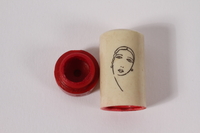
Art Deco style lipstick case carried by a Jewish refugee while searching for her family
Object
Lipstick case carried by Irena Ehrlich vel Sluszny when she walked from Berlin to Warsaw in 1945, in search of her family. Irena, her parents, Felicia and Seweryn, and younger sister, Danuta, were confined to the Warsaw ghetto in 1940. In March 1943, 19 year old Irena escaped to the Christian sector of Warsaw. April 1943 brought the Warsaw ghetto uprising and its violent suppression by the Germans, with mass deportations of all Jews in Warsaw and the annihilation of the ghetto. Her father, aged 39, was killed during the uprising. Her mother and 14 year old sister escaped and were hidden for the rest of the war by Juana Dylag. Irena was deported to a slave labor camp in Berlin. Felicia, Danuta, and Irena were reunited in Warsaw after the war. From 1945-1947, they were in the Bindermichl displaced persons camp in Linz, Austria. They emigrated to the United States on the SS Marine Perch in 1947.
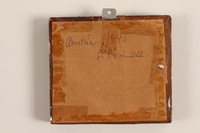
Painting with blind incising used in a displaced persons camp by the Ehrlich vel Sluszny family
Object
A painting that hung on the wall in the room where Irena Ehrlich vel Sluszny and her family lived in the Bindermichl displaced persons camp, from 1945-1947. Irena, her parents, Felicia and Seweryn, and younger sister, Danuta, were confined to the Warsaw ghetto in 1940. In March 1943, 19-year-old Irena escaped to the Christian sector of Warsaw. April 1943 brought the Warsaw ghetto uprising and its violent suppression by the Germans, with mass deportations of all Jews in Warsaw and the annihilation of the ghetto. Her father, aged 39, was killed during the uprising. Her mother and 14 year old sister escaped and were hidden for the rest of the war by Juana Dylag. Irena was deported to a slave labor camp in Berlin. Felicia, Danuta, and Irena were reunited in Warsaw after the war. From 1945-1947, they were in the Bindermichl displaced persons camp in Linz, Austria. They immigrated to the United States on the SS Marine Perch in 1947.
Felicia Erlich photograph
Document
Contains a photograph of donor’s mother, Felicia Ehrlich, in DP camp Bindermichl, in Linz, Austria, wearing the brown jacket/blazer (also donated), circa 1945-1946.
Beige and orange embroidered linen napkin used in the Warsaw ghetto
Object
Napkin made by Irena Ehrlich vel Sluszny, at her school, Perla Lubbinska Gymnasium, in Warsaw, Poland in 1937. Irena, her parents, Felicia and Seweryn, and younger sister, Danuta, were confined to the Warsaw ghetto in 1940. In March 1943, 19 year old Irena escaped to the Christian sector of Warsaw. April 1943 brought the Warsaw ghetto uprising and its violent suppression by the Germans, with mass deportations of all Jews in Warsaw and the annihilation of the ghetto. Her father, aged 39, was killed during the uprising. Her mother and 14 year old sister escaped and were hidden for the rest of the war by Juana Dylag. Irena was deported to a slave labor camp in Berlin. Felicia, Danuta, and Irena were reunited in Warsaw after the war. From 1945-1947, they were in the Bindermichl displaced persons camp in Linz, Austria. They emigrated to the United States on the SS Marine Perch in 1947.
Cream colored handkerchief used in the Warsaw ghetto
Object
Handkerchief that belonged to Irena Ehlrich vel Sluzny's s maternal grandmother, Leokadia Lubelczyk. Leokadia was deported, and it is believed, killed in a concentration camp around 1943. Irena, her parents, Felicia and Seweryn, and younger sister, Danuta, were confined to the Warsaw ghetto in 1940. In March 1943, 19 year old Irena escaped to the Christian sector of Warsaw. April 1943 brought the Warsaw ghetto uprising and its violent suppression by the Germans, with mass deportations of all Jews in Warsaw and the annihilation of the ghetto. Her father, aged 39, was killed during the uprising. Her mother and 14 year old sister escaped and were hidden for the rest of the war by Juana Dylag. Irena was deported to a slave labor camp in Berlin. Felicia, Danuta, and Irena were reunited in Warsaw after the war. From 1945-1947, they were in the Bindermichl displaced persons camp in Linz, Austria. They emigrated to the United States on the SS Marine Perch in 1947.
Orange tablecloth with green flowers used in the Warsaw ghetto
Object
Table cloth used by Irena Ehrlich vel Sluzny's aunt, Margula Ehrlich Kacenhelenbogen, in Warsaw, Poland, in the 1930’s. Margula survived the Holcocaust but lost her husband and two children. Irena Ehrlich vel Sluszny (now Urdang de Tour), her parents, Felicia and Seweryn, and younger sister, Danuta, were confined to the Warsaw ghetto in 1940. In March 1943, 19 year old Irena escaped to the Christian sector of Warsaw. April 1943 brought the Warsaw ghetto uprising and its violent suppression by the Germans, with mass deportations of all Jews in Warsaw and the annihilation of the ghetto. Her father, aged 39, was killed during the uprising. Her mother and 14 year old sister escaped and were hidden for the rest of the war by Juana Dylag. Irena was deported to a slave labor camp in Berlin. Felicia, Danuta, and Irena were reunited in Warsaw after the war. From 1945-1947, they were in the Bindermichl displaced persons camp in Linz, Austria. They immigrated to the United States on the SS Marine Perch in 1947.
Dictionary
Object
Italian/Tedesco dictionary with which Irena Ehlrich vel Sluzny learned Italian in the slave labor camp in Berlin in 1943-1945. Within two months, Irena became a translator for which she was rewarded with an additional ladle of soup at the end of the day. Irena Ehrlich vel Sluszny (now Urdang de Tour), her parents, Felicia and Seweryn, and younger sister, Danuta, were confined to the Warsaw ghetto in 1940. In March 1943, 19 year old Irena escaped to the Christian sector of Warsaw. April 1943 brought the Warsaw ghetto uprising and its violent suppression by the Germans, with mass deportations of all Jews in Warsaw and the annihilation of the ghetto. Her father, aged 39, was killed during the uprising. Her mother and 14 year old sister escaped and were hidden for the rest of the war by Juana Dylag. Irena was deported to a slave labor camp in Berlin. Felicia, Danuta, and Irena were reunited in Warsaw after the war. From 1945-1947, they were in the Bindermichl displaced persons camp in Linz, Austria. They emigrated to the United States on the SS Marine Perch in 1947.
Black fountain pen from the Warsaw ghetto
Object
Fountain pen owned by Irena Ehrlich vel Sluszny that originally belonged to her father, Seweryn, who was killed at age 39, during the Warsaw ghetto uprising in April 1943. Irena, her parents, Felicia and Seweryn, and younger sister, Danuta, were confined to the Warsaw ghetto in 1940. In March 1943, 19 year old Irena escaped to the Christian sector of Warsaw. April 1943 brought the Warsaw ghetto uprising and its violent suppression by the Germans, with mass deportations of all Jews in Warsaw and the annihilation of the ghetto. Her mother and 14 year old sister escaped and were hidden for the rest of the war by Juana Dylag. Irena was deported to a slave labor camp in Berlin. Felicia, Danuta, and Irena were reunited in Warsaw after the war. From 1945-1947, they were in the Bindermichl displaced persons camp in Linz, Austria. They emigrated to the United States on the SS Marine Perch in 1947.



